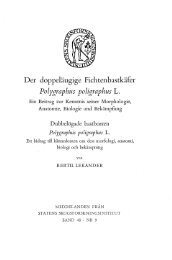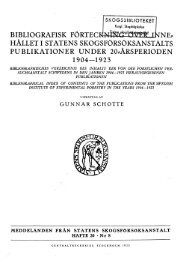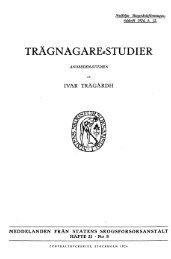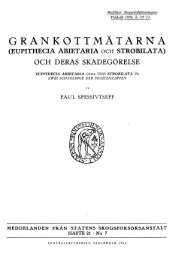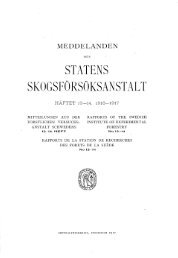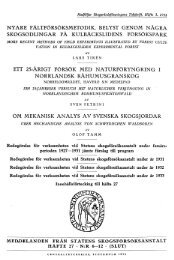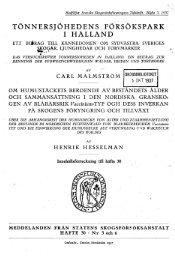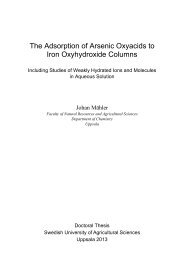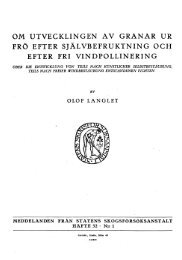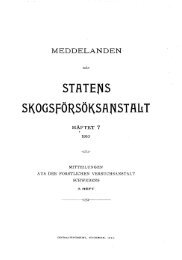SVERIGES LANTBRUKSUNIVERSITET - Epsilon Open Archive - SLU
SVERIGES LANTBRUKSUNIVERSITET - Epsilon Open Archive - SLU
SVERIGES LANTBRUKSUNIVERSITET - Epsilon Open Archive - SLU
Create successful ePaper yourself
Turn your PDF publications into a flip-book with our unique Google optimized e-Paper software.
60<br />
-, Different approaches for calculating tissue parameters from pressure<br />
volume curves have lately been outlined and discussed by Kikuta and<br />
Richter (1986) and Stadelmann (1984). The advantage of the pressure<br />
volUIne method is that apoplastic water does not interfere in the determination<br />
of l/J 7r and also the elasticity of the tissue can be quantified. An<br />
useful ecological interpretation of pressure volume curves is given by Jane<br />
and Green (1983) and Bannister (1986).<br />
Measurement of stornatal conductance and gas exchange<br />
The epidermis of leaves creating the boundary between le af interior and<br />
the atmosphere is covered by a relatively impermeable cuticle except at<br />
stomata openings through which gases (C0 2 and water vapour) mainly<br />
exchange between the leaf interior and the atmosphere. When water<br />
deficits develops in the leaves the turgor regulated stornatal cells close with<br />
the consequent reduction in transpiration and CO 2 uptake. Thus it is<br />
important to measure stornatal opening directly from stornatal impressions<br />
or by measuring the rate of gas exchange.<br />
Stornatal impressions can be obtained by applying a quick - drying<br />
substance to the leaf surface followed by microscopic countings and<br />
measurements of stornatal opening on the impressions (Rice et al., 1979).<br />
Stornatal opening can be converted into diffusive resistance (Meidner and<br />
Mansfield, 1968).<br />
Stornatal conductance can be calculated from measurements of water<br />
vapour loss in leaf chambers under laboratory conditions (Sestak et al.,<br />
1971). However, for field conditions more simple portable technique is<br />
required in order to obtain many determinations and hereby reduce the<br />
statistical uncertainty. This claim has been met by the introduction of<br />
diffusive porometers and most work on stornatal resistance is now carried<br />
out with such porometers based on a electronic moisture - sensor system.<br />
These instruments measure the diffusion of water vapour away from the<br />
leaf and are of two basic types the "transient" and "steady state" porometer.<br />
In both types the leaf is enclosed in a cuvette which may be ventilated.<br />
Ventilation reduces the boundary resistance layer to a low value. However,<br />
ventilation may increase the evaporative loss and induce stornatal closure.<br />
Non -ventilated transient porometers are relatively cheap and instruments<br />
are commercially available (e.g. "Delta T Automatic Porometer Mk III",<br />
Delta-T Devices, Cambridge, U.K.).<br />
In steady state porometers, which are always ventilated, the relative<br />
humidity is maintained at or near ambient humidity. Stornatal resistance<br />
is derived either from the increase in humidity in the air passing the leaf<br />
or from the rate of inflow of dry air needed to maintain a constant<br />
humidity. These instruments are also commercially available (e.g. "LI -1600<br />
Steady State Porometer", LiCor Inc.).





